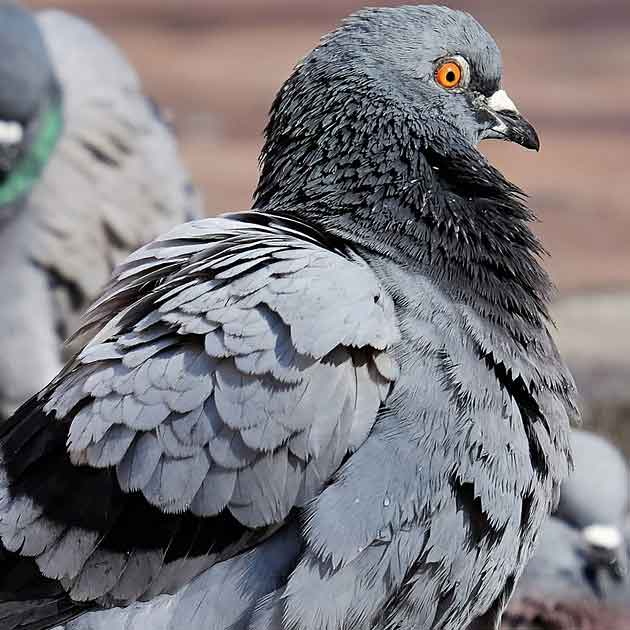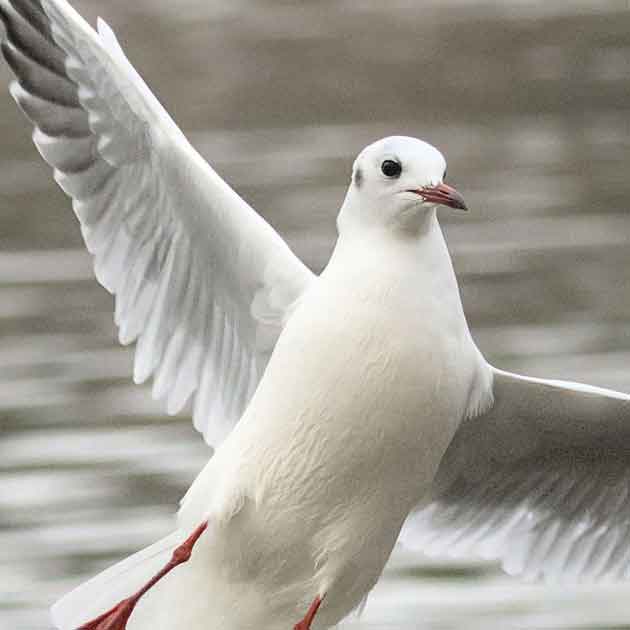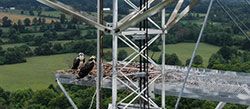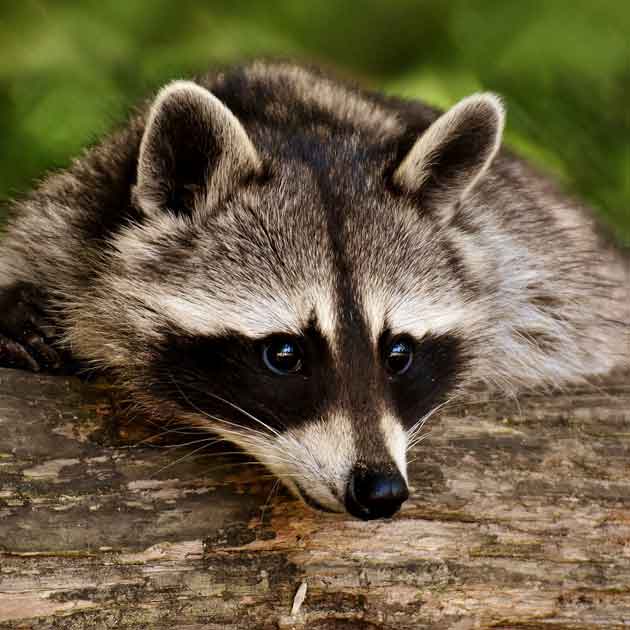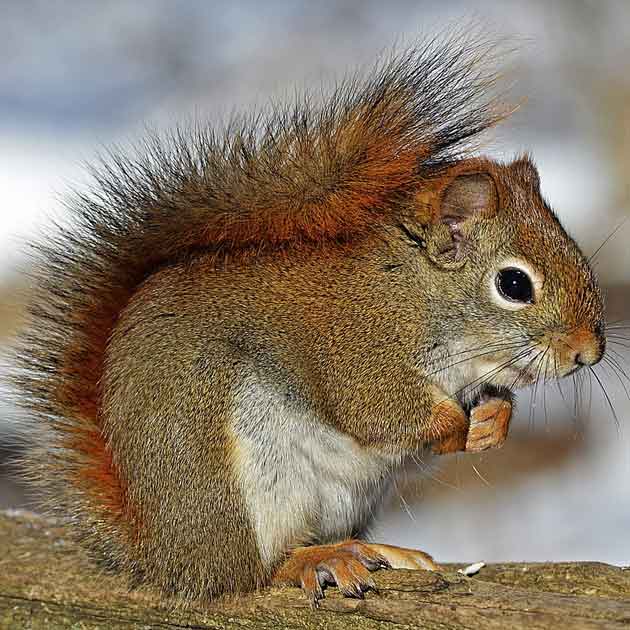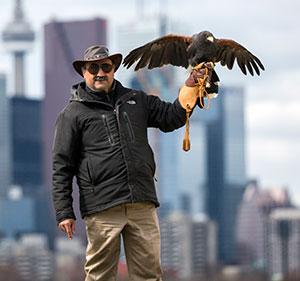BLOG | Hawkeye
News, little truths and wisdom regarding Pest Bird & Animal Wildlife Control, Falconry, and Birds of Prey....
How to Get Rid of Skunks in Window Wells
- Written by: Dan Frankian
The window well we're talking about is the gap the between ground level and basement windows. That space that almost guaranteed you won a hide-and-seek game when you were a kid. While human youngsters may jump down into window wells on purpose, some unfortunate wildlife (most often skunks) end up there entirely unintentionally.
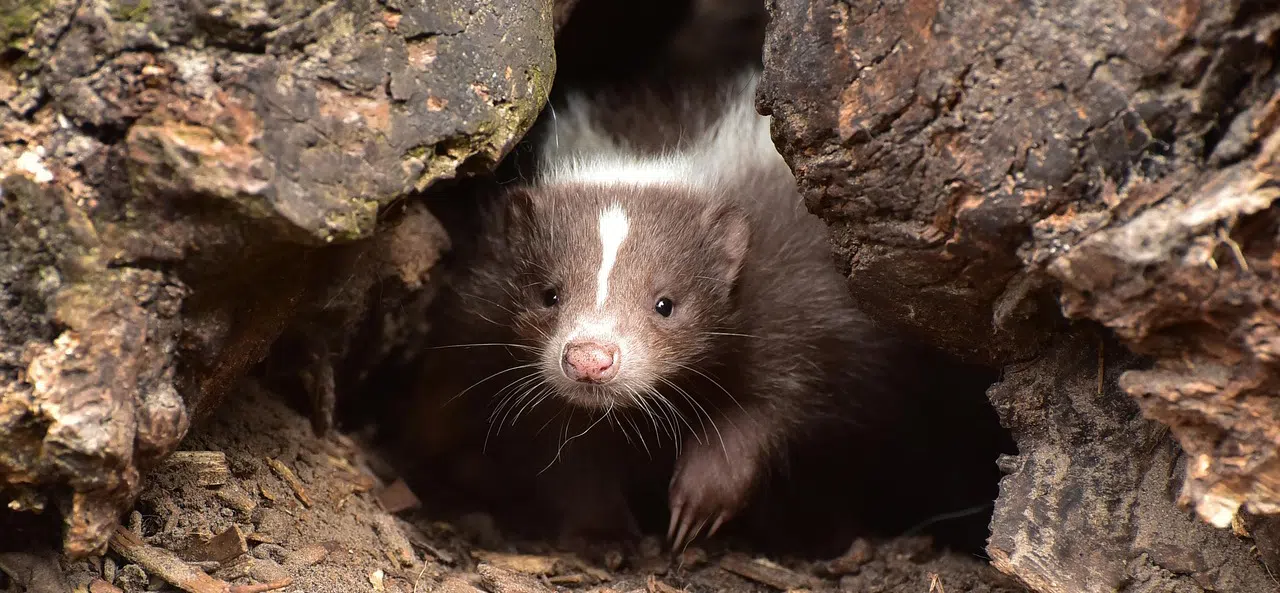
While skunks are actually better equipped to see in the dark than during daylight hours, their eyesight (peripheral vision, in particular) is not the most impressive in the animal kingdom. They mostly navigate by smell and hearing, and those senses are highly developed. So, being a bit on the clumsy side and definitely not known for their agility, short, stocky, and slow-moving skunks can quite easily take a tumble and get trapped in a window well, unable to escape due to its depth.
Surely, homeowners and animals alike will want to end the predicament of a skunk in a window well in a hurry, but doing so may not be such an easy task - at least not without some resistance and the unmistakable aroma that tends to linger long after the animal has vacated the premises.
So, what is the best way to get rid of skunks? Unlike other animal control companies, Hawkeye Bird & Animal Control offers legal and sanctioned skunk removal methods beyond trapping and relocation.
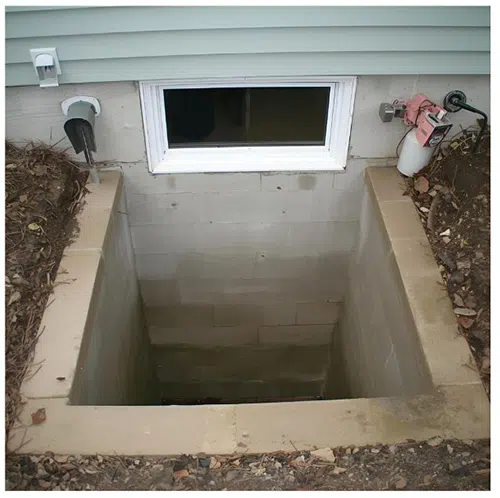 Why Skunks Fall into Window Wells
Why Skunks Fall into Window Wells
As mentioned above, skunks aren't famous for their eyesight or athletic abilities - and in normal, everyday skunk life, that's fine. But when it comes to navigating around human structures, this can get them in trouble fast. So, let's have a look at reasons within our control that these creatures might fall into a home or building’s window wells, so we can help prevent the situation in the first place.
- Absence of Covers or Caps over Window Wells
Covering a basement window well not only protects it from unexpected animal visitors but also helps it stay clear of debris, water, and snow. Cover options range from polycarbonate covers to sturdy metal grates. - Overgrown Vegetation
Trimming back vegetation may aid in making the window well more visible as well as make it less likely to attract insects (a favourite food source for skunks!) in your yard. - Clutter and Food Sources
Getting rid of yard clutter that may attract nightly exploration and removing food sources like pet food will make your yard less of a draw for skunks (and other wildlife). And don't forget to secure your garbage bins. Skunks are scavengers and will happily raid your trash.
Seasonal Patterns of Skunks in Window Wells
The chance of a skunk ending up in your window well is greatest from spring to autumn. While skunks do not hibernate, they enter a state of torpor during the winter months which results in much sleep and reduced activity to conserve energy.
- Spring
This season is full of activity - young mother skunks are out 'n about foraging to feed themselves and in turn, nurse their babies. Trapping a skunk while she's caring for her young would be even more tragic in spring time, as newborn skunks are born blind and deaf and completely dependent on their mother for survival. - Summer
Window well accidents may be even more likely during the summer, the later part in particular, as young skunks begin to roam the outside world and learn to forage on their own. Summer also offers fruit trees, berries, and vegetable gardens for skunks to explore in your yard. - Fall
Fall sees young skunks venturing off on their own and into early adulthood. Feeding and putting on weight for winter is the main focus now. As food sources become more scarce and the need to find a suitable winter den becomes urgent, skunks are more likely to explore areas close to human dwellings. - Late Winter
Skunks are among the first to say "nuts to this" and emerge to engage in mating rituals, hence signaling the end of winter. By the end of February, eligible skunks are on a mission to find a mate. Males will travel up to five miles to mate with as many females as possible. It's a busy time of year :)
Get Pest Birds Out Of Warehouses and Box Stores
- Written by: Dan Frankian
Plummeting temperatures and the onset of winter have pest birds such as pigeons, starlings, and sparrows looking for warmth and shelter in commercial buildings including warehouses, box stores, and large manufacturing and storage facilities. Depending on the use of the facility, this can lead to catastrophic product and financial loss as well as health and legal consequences.

In this article, we'll explore how to eliminate pest birds who congregate and roost in large commercial facilities and mitigate the risk to your product, profit, health and reputation.
What Type of Bird is Found in Commercial Production and Storage Facilities?
Here, in the GTA and in fact all across southern Ontario, we typically find sparrows, pigeons and starlings in facilities that produce and/or store food, medical products, and box stores. Depending on the type of facility, the commercial bird control approach to getting these birds out may differ.
What Kind of Facilities Do Pest Birds Target?
Pest birds can be found any time of the year in any space they're allowed to linger. Of course, if this happens to be a facility where food is produced or stored, it's even more popular. As winter approaches, birds seek to get out of harsh winds and freezing temperatures - no surprise there. Large warehouses or manufacturing facilities, box store, or airline hangars offer a somewhat controlled climate, rafters perfect for roosting, and thanks to frequently open loading docks, the option to come and go as one pleases. If one was a bird :)
Why Are Birds in Storage Facilities Dangerous?
Birds are pretty to look at and listen to, but they are anything but clean and can cause havoc in commercial settings in no time at all. Bird feces and feathers are entirely unsanitary.
- Health Hazard from Bird Feces
Bird feces accumulate quickly and contaminate both product and packaging. It's even worse when feces is allowed to dry and is then disturbed (i.e., by sweeping up). Pathogens become airborne and pose a serious health risk to workers. - Health Hazard from Bird Feathers
Feathers also carry a host of diseases and parasites which are easily transferred to anything they come in contact with. - Corrosion From Bird Feces
Bird feces are highly acidic and corrosive; they can permanently damage steel beams and threaten the structural integrity of your building. - Regulatory and Legal Issues
The presence of pest birds is an automatic fail during any health inspection. You may incur reprimands, license suspension, and fines. - Loss of Income and Productivity
Having failed mandatory inspections, you may end up having to dispose of entire pallets of products and/or halt production until the birds have been eliminated and the entire facility has been cleaned and disinfected.
How to Identify and Remove Raccoon Dens in Winter
- Written by: Dan Frankian
With its freezing temperatures and harsh winds, Ontario winter forces raccoons to abandon flexible den habits for a single warm, secure location, creating a high-risk, long-term raccoon infestation in winter, which lasts until spring and beyond. Identifying and addressing these primary dens in the cold months is crucial to preventing structural damage and costly spring repairs.
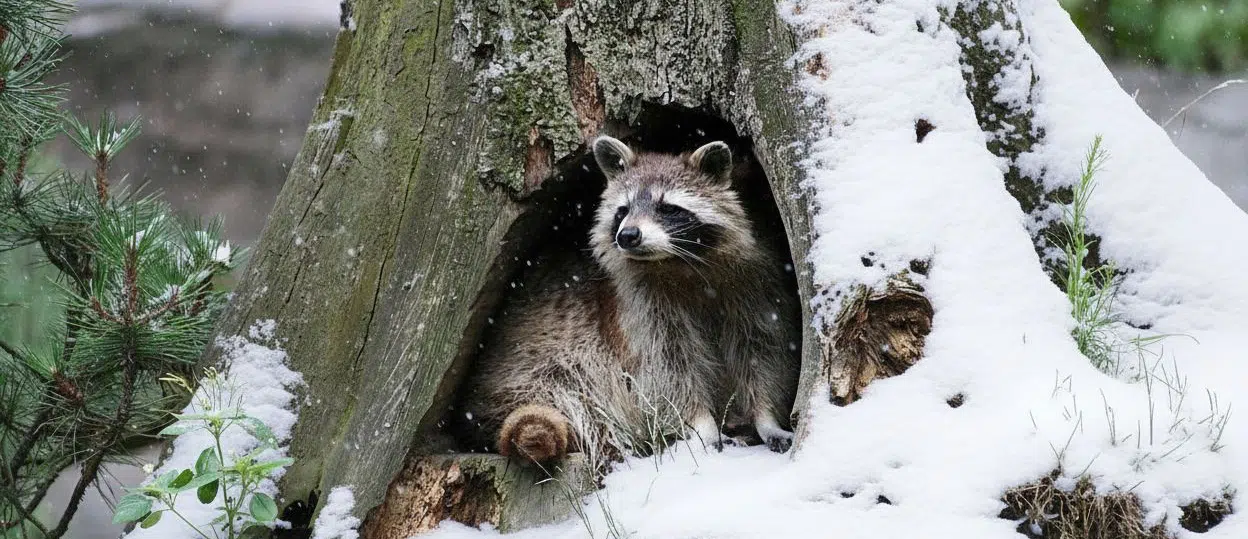
Raccoon Winter Behaviour in the GTA
After a flurry of activity during the fall months where their focus was on calorie intake, raccoons settle into long winter naps once the snow arrives. Focus is now on staying warm and safe from predators. This behaviour is one of the reasons homeowners and commercial/industrial property managers should search for winter raccoon control early in the season, before a raccoon infestation is too entrenched.
- Torpor, Not Hibernation
Raccoons do not truly hibernate but rather enter a state of torpor—a deep sleep broken by periods of waking. While in this state, their body temperature lowers, and breathing and metabolism slow to conserve energy. They will keep a single, secure den for weeks at a time to conserve energy and survive freezing temperatures. - The Thermal Imperative
During the winter months, raccoons seek out areas with trapped heat (i.e., from the house, equipment, or ground) and maximum wind protection. This commitment to one warm spot makes winter dens extremely destructive. - Reduced Activity, Increased Risk
While they forage less often, raccoonss' activity when inside the den is focused on insulating and securing the perimeter by procuring and using any suitable materials. This often results in severe damage to building insulation, etc.
Where Raccoons Den in GTA Winters
Where do raccoons usually nest during colder months? Residential, commercial, and industrial properties offer a plethora of options.
- Structural Areas (Warmest Spots):
- Attics:
Attics are probably the most sought-after spot for raccoons (and other wildlife - think squirrels!) to wait out old man winter. Proximity to chimneys or plumbing stacks and just the rising heat from floors beneath make attics perfect for winter denning. Raccoons access attics through the roof and poorly sealed roof vents. - Chimneys:
If uncapped, your chimney can provide a dark, contained vertical shelter. - Garage Ceiling Voids:
The insulated space above an attached garage creates a thermal bridge to the main house/building. It is also safe and enclosed with little to no human traffic.
- Attics:
- Ground-Level Havens (Insulated Spots): Areas that hold ground heat and are protected from the wind and snow.
- Crawl spaces:
Crawl spaces underneath a structure provide consistent, moderate warmth. - Window Wells Basement Voids:
Small, contained pockets near the foundation may also be converted to a winter den. - Sheds/Deck Voids:
Areas under sheds or decks, especially if the ground is skirted, trap heat and provide sufficient shelter.
- Crawl spaces:
- Commercial Industrial Spots (High-Value Warmth):
- Warehouses and Factories:
Heat from machinery or HVAC vents attracts raccoons. Low-traffic areas like maintenance rooms should be inspected regularly. - Abandoned or Low-Traffic Buildings:
Quiet, undisturbed areas still draw furry winter dwellers, even if not actively heated. Raccoons can evade detection for months in abandoned or vacant properties. - Seasonal Businesses and Schools:
Buildings that are closed for periods of time, such as schools often see raccoon invasions. By the time the animals are detected, it's often too late and significant damage has been done. - Loading Docks:
Open loading dock doors invite raccoons inside to explore hidden spaces for temporary dens.
- Warehouses and Factories:
- Natural/Outdoor Denning Spots near Homes:
- Hollow trees, brush piles, abandoned burrows, woodpiles, and old cars/trucks and machinery also make for suitable raccoon winter dens.
- Hollow trees, brush piles, abandoned burrows, woodpiles, and old cars/trucks and machinery also make for suitable raccoon winter dens.
Read more: How to Identify and Remove Raccoon Dens in Winter
How to Get Rid of Raccoons in Greenhouses
- Written by: Dan Frankian
Winters in Southern Ontario can be harsh and long. In order to survive, our local wildlife often moves closer to people’s homes and businesses and backyard or commercial structures such as greenhouses. Animals like raccoons seek out shelter, warmth, and food and all of that can be found in residential backyard greenhouses, commercial agricultural greenhouses and nurseries, as well as community or educational garden structures.

The negative and often costly impacts of raccoons invading greenhouses include crop destruction (especially fruits and plants), feces contamination, and structural damage. That’s why wildlife control for greenhouses is so crucial and permanent raccoon removal for horticultural facilities is something that should strongly be considered.
Why Greenhouses Are Raccoon Magnets
- Guaranteed Climate and Shelter
Greenhouses are kept warm and humid year-round, thus offering an ideal refuge from freezing winter temperatures and wind. - Abundant, Accessible Food
Raccoons are attracted by soft, ripe produce (tomatoes, peppers, berries), potting soil amendments (bone meal, organic fertilizer), and rodent populations thriving on seeds/spills. And then there's garbage or compost bins - those are also very applealiong. - Constant Water Source
Irrigation systems, condensate lines, and humidity trays provide easily accessible fresh water, a critical raccoon attractant, especially during dry seasons.
How Raccoons Enter Greenhouses
- Plastic/Fabric Cover or Vents
Raccoons easily tear through the light plastic or screen mesh used on the outer layer of a backyard greenhouse or automated roof or side wall vents. - Sliding Door Gaps
Cold and desperate raccoons exploit worn or damaged seals on large sliding doors used for vehicle/equipment access. - Utility/Pipe Tunnels
They can enter through unsecured maintenance tunnels or gaps where main water lines or heating pipes penetrate the foundation.
Signs of Raccoon Presence in the Greenhouse
While a slew of small critters are likely to camp out in your greenhouse for the winter, the scope and size of damage you're seeing should give you a good idea of the type of animal sharing your space.
- Disturbed soil, torn plant roots, missing produce.
- Nocturnal noises or tracks near entry flaps.
- Droppings, foul odour, or insulation shredded for nesting.
Overall, the signs of a raccoon infestation in your greenhouse are similar to those you would look for in your home. Have a look here: https://www.hawkeye.ca/blog/10-tell-tale-signs-you-have-a-raccoon-in-your-home.
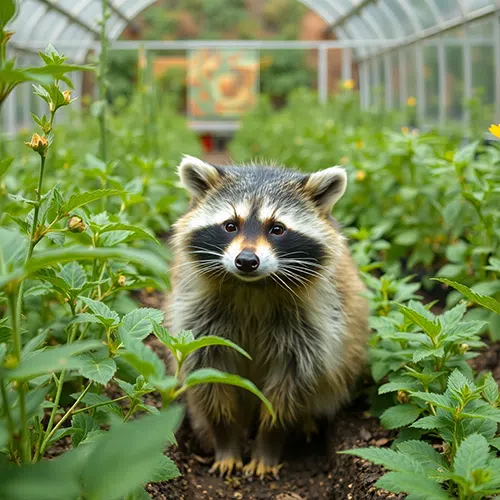 Critical Risks of Raccoon Infestation in Greenhouses
Critical Risks of Raccoon Infestation in Greenhouses
Crop Contamination and Financial Loss
Raccoons claw and bite through high-value crops, causing direct product spoilage. Contaminated produce often mandates the disposal of entire rows or benches of plants due to the presence of feces/urine and the risk of rabies transferred by an infected animal's saliva.
Climate Control Failure
Raccoons nesting near heating elements, fans, or control panels can chew wiring or block airflow, leading to HVAC or ventilation failure. This leads to the risk of overheating, freezing, or improper humidity control, potentially destroying not only the equipment, but also the entire growing environment.
Structure Compromise (Glass/Plastic)
Raccoons scratch and tear the plastic sheeting or seals around glass panes, compromising the greenhouse's thermal envelope. This leads to massive heat loss, increased utility bills, and exposure of the interior to weather.
Regulatory & Liability Exposure
The presence of raccoon feces in a food-producing environment is an immediate health inspection failure (Canadian Food Inspection Agency/local health unit), risking shutdown, fines, and the imposition of strict biohazard cleanup requirements.
How to Keep Raccoons Out of a Greenhouse
- Inspect and reinforce your structure's integrity before winter.
- Use heavy-duty mesh or wire to seal ventilation openings.
- Keep compost and garbage sealed tightly and away from the structure.
- Install automatic lighting or motion sensors to alert you to movement.
- Maintain a clean perimeter—remove all fallen fruits, pet food, or debris.
- Make use of natural deterrents such as strong-scented herbs.
How to Get Rid of Raccoons from Crawl Spaces
- Written by: Dan Frankian
Do you think you might have raccoons in a crawl space in your building? Here’s everything you need to know in terms of wildlife control and beyond, whether your property is residential or commercial, urban or rural.
First off, a crawl space is a shallow space, often beneath the first floor of a building, which represents a raccoon’s ideal sanctuary. It provides guaranteed warmth, dryness, and darkness—perfect for year-round shelter and crucial for winter denning. An infestation here is a direct threat to a building’s structural health, utilities, and indoor air quality and this is true for both homes and businesses with raised foundations or subfloors .

You might not even realize you’re sharing your foundation with an entire raccoon family until it’s too late!
Why Raccoons Choose Crawl Spaces
- Crawl spaces offer warmth during the winter and protection from predators.
- Insulation materials make them ideal for nesting.
- Food waste, pet food, or compost bins often are nearby.
- Access is facilitated by small foundation gaps, vents, or loose grates.
What Types of Properties Are at Risk?
Residential
- Older homes with wooden foundations or open vents.
- Mobile homes and enclosed trailers.
- Houses with easy backyard access, pet feeding areas, or gardens.
Commercial
- Restaurants or food service buildings with nearby dumpsters.
- Warehouses or storage units built on raised concrete pads.
- Multi-unit housing complexes with utility crawl spaces.
Rural or Suburban Properties
- Farmhouses or cottages with unsealed crawl access points.
Signs of a Raccoon Infestation in Crawl Spaces
- Scratching, thumping, or chirping at night.
- Strong ammonia-like odour from urine and feces.
- Torn insulation or ripped vapor barriers.
- Droppings, tracks, and greasy rub marks near vents or foundation openings.
Get Rid of Raccoons in Vehicle Tarp Shelters
- Written by: Dan Frankian
Portable garages, tarp sheds, and construction canopies are often used for crucial winter storage of vehicles, equipment, and materials. These structures offer raccoons a perfect, insulated hideaway in the harsh Canadian cold, leading to immediate destruction of the fabric shell and contamination of valuable assets inside.

The risk is highest in late fall and during the first few weeks of snowfall. As temperatures drop, these sheltered spaces become irresistible, and a desperate raccoon will rip through vinyl and fabric walls in minutes to gain access.
Why Raccoons See Tarp Shelters as Ideal Winter Dens
- Wind and Cold Barrier
Even thin fabric traps air and blocks wind, creating a significantly warmer environment than the outside. When enclosed, these types of shelters become essential for a raccoon’s winter survival. While raccoons don't truly hibernate throughout the winter, they do enter torpor, a period of hours or days when their body temperature drops and the respiratory system slows down to conserve energy. - Ease of Access
Because these enclosures cannot be locked tightly, they are easily breached.- Claw and Tear
Raccoons use their strong claws to quickly tear through thin vinyl, polyester, or polyethylene fabrics. - Zipper/Velcro Exploitation
Raccoons have the dexterity to pull apart loose zippers or Velcro seals at door entrances. - Ground Gap Entry
They lift or push under loose bottom edges where the fabric meets the ground or snow.
- Claw and Tear
- Available Materials
The shelter often contains materials that can be used to build or line a den. This can include cardboard boxes, stored fabrics, packaging, or even seat foam from stored vehicles.
Signs of Raccoon Activity in Tarp Shelters
- Torn tarp corners or claw marks near entry flaps.
- Displaced vehicle covers, insulation, or shredded fabrics.
- Droppings or urine odour near vehicles or storage bins.
- Unexplained noises (scratching, rustling) especially at night.
- Tracks or muddy paw prints near shelter entrances.
Risks and Damages Caused by Raccoons in Tarp Shelters
Asset Contamination and Loss
- Vehicle Damage
Raccoons chew on electrical wiring, ignition components, or rubber hoses within stored vehicles, or rip up seat foam and upholstery for nesting material. - Inventory Contamination
Feces and urine contaminate stored materials (e.g., lumber, insulation, retail goods) that must then be discarded.
Structural Integrity Failure
The primary structure is the fabric, so a raccoon breach renders the shelter useless, accelerating moisture and weather damage to stored items inside.
Insurance and Liability (the Policy Gap)
Standard property insurance often excludes damage to contents inside temporary structures or damage caused by wildlife. The entire financial burden of repair and asset replacement falls directly on the owner.
Seasonal Risks: Are Tarp Shelters More Vulnerable in Winter?
- Raccoons actively seek warm, enclosed areas during cold months.
- Snow accumulation can collapse parts of the shelter, creating hidden spaces that raccoons use for dens.
- Reduced usage in winter means infestations often go unnoticed for a longer period.
Pro-Tip: Plan on routine mid-winter inspections of your structure's tarp integrity and anchor points.
How to Get Rid of Raccoons in Solar Panels
- Written by: Dan Frankian
While you are diligently investing money into your commercial property and renewable energy, your solar installation might be multi-tasking as a warm and sheltered nesting spot for opportunistic raccoons.
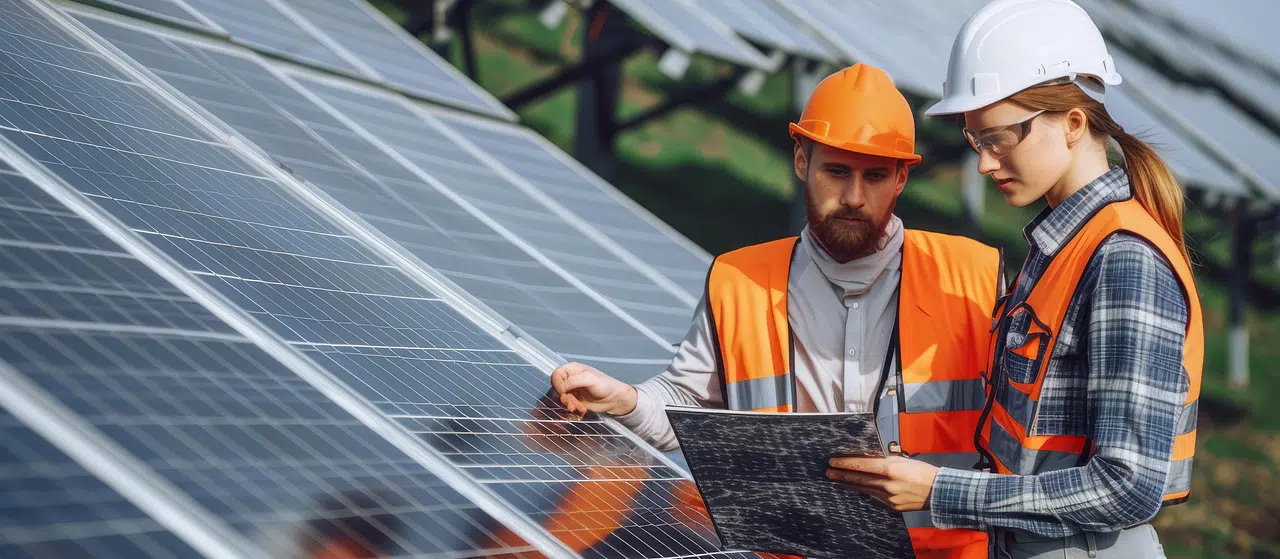
A steady increase in urban raccoon population is leading to business owners reporting more and more wildlife on roofs and under solar panels. This article will explore the reasons behind raccoon infestations under or around solar panels in both homes and commercial buildings in the GTA and what to do about them. When it comes to raccoon removal from solar panels, remember that there is only one company in Toronto and the GTA that offers a truly permanent solution - unlike trapping and relocating: Hawkeye Bird & Animal Control.
Why Do Solar Arrays Attract Raccoons?
The answer to this question is two-fold: Residential solar installations are usually mounted only 2-3 inches above the roof, so raccoons cannot fit under there. But, raccoons will still seek out solar arrays on sloped roofs to exploit the structural weakness created by the mounting brackets and to access the attic. On commercial roofs, solar arrays have a much larger gap between the roof and solar panels, so raccoons can actually use the space between as a shelter.
- The Thermal Advantage (Year-Round)
Solar panels act like a thermal blanket. They absorb massive amounts of sun/heat, and the space between the panel and the roof traps that heat, creating an ideal, insulated micro-climate critical for survival during freezing winter nights and extreme summer heat. - Safety and Seclusion
The tight space and height offer perfect protection from ground-dwelling predators and human disturbance, making it a preferred location for birthing and nesting. - Easy Access
Raccoons can use nearby trees, perimeter roof edges, or downspouts to gain access to the roof, then slide directly under the panels where they are completely hidden. - Proximity to Food Sources
Garbage bins, compost, bird feeders, and nearby gardens provide a tasty buffet for resourceful raccoons.
Types of Properties Affected by Raccoons
The problem of raccoons around solar panels becomes more pronounced during the colder months as animals seek warmth and protection from the elements.
 Residential Properties
Residential Properties
- Detached homes and townhouses;
- Rural properties with solar panels;
- Raccoons seek to gain access to the attic through the roof and by exploiting potential weaknesses created by the solar panel mount.
Commercial & Industrial Properties
- Warehouses, factories, and retail stores with rooftop solar systems;
- Commercial buildings with large flat roofs are at greater risk due to panel quantity and hidden spaces;
- Raccoons will build nests (called dens) in the space between the solar panel and roof.
Signs of Raccoons Under or Around Solar Panels
- Scratching, thumping, or movement noises, particularly at night;
- Damaged wiring or insulation beneath panels;
- Feces and urine accumulation on rooftops;
- Visible claw marks on pipes or other access ways to the roof;
- Loose or shifted panels;
- Debris or nesting materials visible under panels or near gutters,
- Reduced solar efficiency due to wiring damage.
Raccoons Infesting Structural Steel I-Beams and Bridges
- Written by: Dan Frankian
Raccoons infesting I-beams and bridges often exploit gaps in hollow structural steel elements, including box girders or bridge abutments for shelter. This is not just a pest problem; it's an infrastructure integrity and corrosion hazard that poses serious financial risks and can have catastrophic consequences to human life.
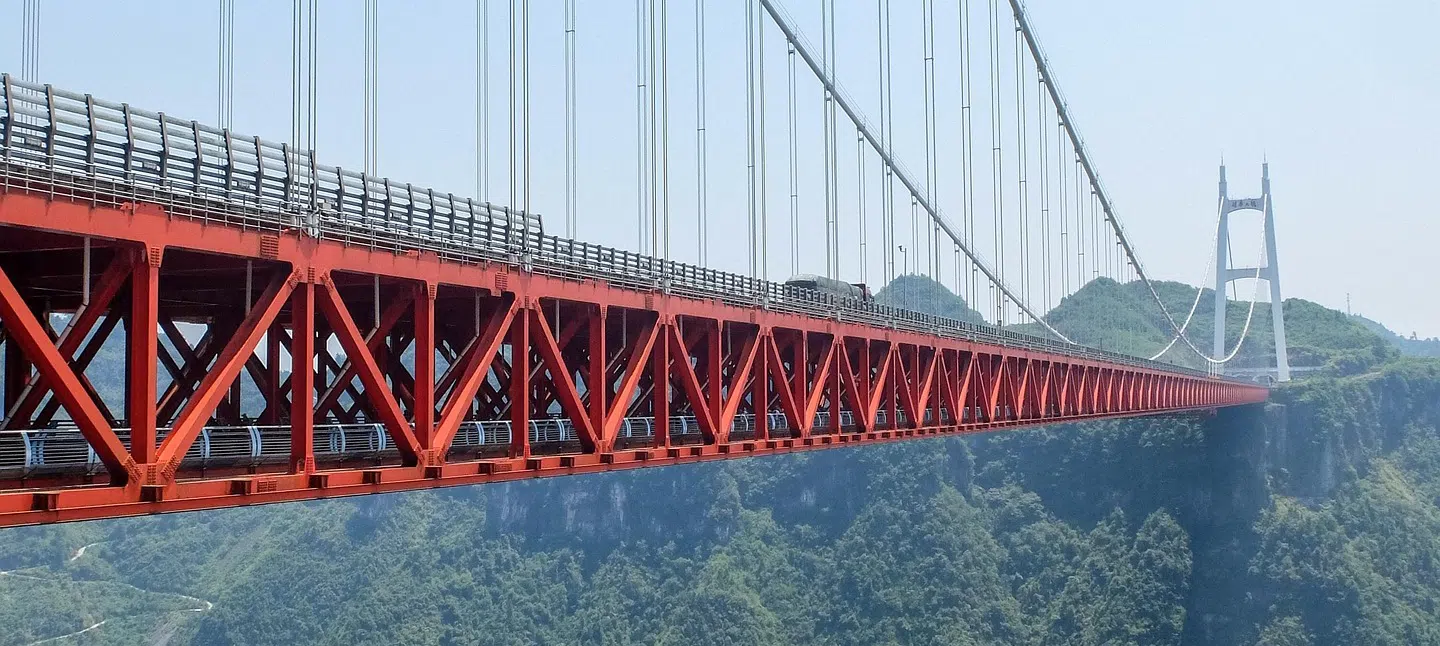
Raccoons can breach high-strength steel structures by exploiting existing flaws. These can include:
- Weld Seam Gaps
Hairline cracks or openings in aging or compromised weld joints and metal seams can offer enough space to allow for an entry point. - Unsealed Access Panels
Raccoons pry open degraded or poorly sealed maintenance hatches and inspection ports meant for accessing conduits or lighting. - Conduit Penetrations
Small holes where exterior electrical conduits, grounding wires, or drainage lines pass through the steel casing can be enlarged by a determined raccoon.
Why Raccoons Target Steel I-Beams and Bridge Structures
Hollow steel beams and supports mimic the natural environment suited to a raccoon den location. Trapped air and residual warmth from the surroundings (or slight heat from mechanical vibration/conduits) create a warm, insulated and wind-free micro-climate ideal conditions for a winter shelter. Let's look at this in more detail:
- Warmth Retention
Steel retains heat during sunny winter days, creating cozy nesting spots. - Elevation & Safety
Height deters predators and human interference. - Seclusion
Low human traffic at night, especially in industrial or bridge areas helps create a safe environment. - Proximity to Water
Bridges in particular are popular with raccoons because of nearby water. Not only is water important for hydration, but raccoons also 'wash' their food before consumption.
Types of Properties and Structures Affected by Raccoons
Raccoon infestation under bridges is a particularly common phenomenon due to the warmth, elevation, and proximity to water that these structures provide.
- Industrial Complexes
Factories, refineries, and storage facilities offer shelter and often food as well. - Municipal Infrastructure
Bridges, overpasses, and storm drains provide the added bonus of close proximity to water. - Commercial Sites
Parking structures and logistics hubs are usually quiet and secluded overnight. - Construction Projects
Incomplete steel frames or equipment also offer shelter. - Public Areas
Pedestrian bridges or park structures often offer multiple benefits.
Risks of Raccoon Infestation on I-Beams & Bridges
A raccoon infestation on bridges can accelerate corrosion and structural decay, especially when droppings collect inside enclosed steel cavities. Here’s a breakdown of the risks:
- Accelerated Internal Corrosion
Highly acidic raccoon urine and feces accumulate inside the hollow steel cavity. This accelerates rust and corrosion on the interior surfaces, which are often difficult to inspect or recoat. - Loss of Structural Integrity
Corrosion reduces the cross-sectional area of the steel, compromising its load-bearing capacity over time. Several bridge collapses in the past had corrosion from animal matter as contributing factors. - Contamination and Fire Risk
Raccoons often drag nesting materials (i.e., insulation, plant matter, and plastic) inside, which can clog drainage holes in the beam or accumulate near electrical conduits, creating a fire hazard. - Inspection Failure
For municipal or industrial infrastructure (e.g., loading dock bridges), evidence of pest infestation and corrosion can lead to a failed structural inspection and mandated closure or costly emergency repair. - High Access Costs
The removal, cleanup, and structural repair of these areas require specialized high-reach equipment including lifts or scaffolding and certified technicians, making recurring problems exponentially more expensive. - Public Health Concerns
- Leptospirosis, raccoon roundworm, and parasites in droppings.
- Droppings falling onto walkways or vehicles below bridges.
- Contamination risks for workers and water below.
Read more: Raccoons Infesting Structural Steel I-Beams and Bridges
Raccoons on Construction Sites and in Unfinished Buildings
- Written by: Dan Frankian
Construction sites and partially completed buildings are high-risk targets for raccoons in the GTA, especially when cold weather hits. While tool storage areas and unused structures or equipment provide shelter, protection, and warmth, construction materials like insulation easily double as den linings. Food scraps and trash add to the attraction of construction sites.

Such infestations pose serious health and safety risks, compromise materials and the structural integrity of building projects, halt inspections, and create legal liability for construction companies, property owners, and developers. Of course, nearby residents will often notice a stark increase in raccoon sightings in their own backyards.
Why Unfinished Construction Sites Attract Raccoons
Construction sites are generally quiet and free of activity during the hours between dusk and dawn - and this is precisely when raccoons are most active. Here are some other considerations:
The Perfect Microclimate
In a newly constructed building, a roof structure is often finished long before the interior walls are sealed. This creates a large, enclosed space that traps residual heat from the concrete foundation and shields the entire area from wind, offering a safe, dry "micro-climate" that’s perfect for winter torpor.
Abundant Nesting Material for Raccoon Nesting Sites
Readily available materials including loose insulation, cardboard packaging, plastic sheeting, and discarded fabric are all utilized by raccoons to create insulated winter dens.
Ease of Access
Unlike finished buildings, construction sites are rarely fully sealed. Raccoons exploit:
- Uncovered elevator and utility shafts.
- Missing windows/doors (covered only by poly sheeting).
- Open joists and wall cavities.
- Unfinished roofing/venting penetrations.
- Unsealed vents, ducts, or chimneys.
- Gaps in temporary fencing or plywood barriers.
- Damaged tarps, scaffolding openings, or roof gaps.
- Open basement or utility access points.
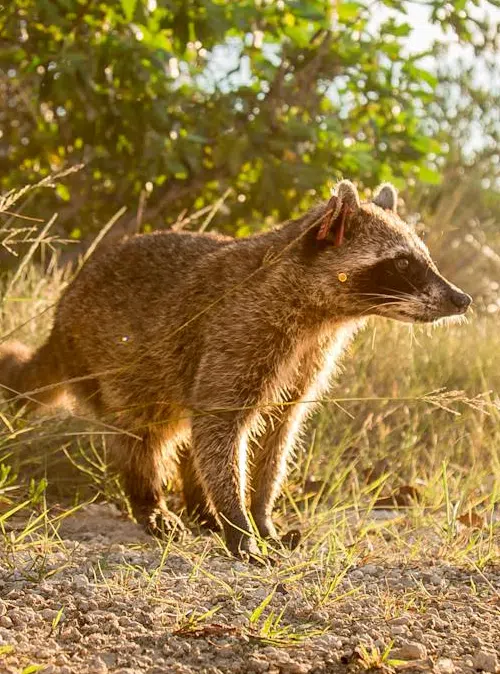 Raccoon Removal in Unfinished Buildings & Construction Sites: The Cascading Costs and Liability Risks
Raccoon Removal in Unfinished Buildings & Construction Sites: The Cascading Costs and Liability Risks
Financial Impact (Project Delays)
The discovery of wildlife can halt all work in that section of the site until animals and biohazards are cleared. This leads to costly project delays, wasted labour time, and potentially missing milestone deadlines.
Compromised Materials & Structure
- Insulation & Drywall
Urine, feces, and trampling/scratching damage destroy insulation (requiring costly replacement) and stain unfinished drywall or wood. - Chewed Wiring
Raccoons chew on low-voltage wires and exposed electrical conduits, leading to faults that must be traced and rewired by licensed electricians before walls are sealed. If left unchecked, this can lead to fires.
Adjacent Property Risk (The Spread)
Raccoons often use vacant building as a hub. They commute to nearby finished properties (e.g., adjacent homes or neighbouring businesses) for food, increasing conflict within the community and drawing negative attention to the ongoing construction project.
- Migration Effect: Once construction is completed, raccoons may move to nearby homes, offices, or condos.
- Cross-Infestation Risk: Neighbouring buildings face increased intrusion pressure.
- Garbage Attraction: Improper waste management at construction sites draws raccoons into the area, spreading problems to surrounding neighborhoods.
Read more: Raccoons on Construction Sites and in Unfinished Buildings
Raccoon Removal for Commercial Food Storage Areas
- Written by: Dan Frankian
Raccoons are opportunistic nocturnal feeders that prefer low-effort and widely available food sources. That's why we see such a widespread increase in urban raccoon population, particularly during the winter months.

Commercial food storage areas are at a higher risk of raccoon infestations because of the availability and easy access to large quantities of food. While raccoons pose a number of issues in any urban setting, the consequences at food storage facilities are greatly multiplied. Such consequences include product contamination, health hazards, property damage, and legal liabilities.
Once a raccoon infestation is suspected or confirmed, it is vital to call in a professional, licensed commercial raccoon removal service for immediate and permanent results.
FAQs: Raccoons in Food Storage Areas
Q: Will the Canadian Food Inspection Agency (CFIA) fine us if they find raccoon droppings?
A: Indeed, raccoon droppings are a serious sanitation issue, evidence of failure in a company's pest control measures and subject to fines and other penalties. Here's what the Government of Canada states on this issue: "When businesses fail to comply with their obligations under the Safe Food for Canadians Act and the Safe Food for Canadians Regulations with respect to ensuring the safety of food, the CFIA has several enforcement tools at its disposal such as monetary penalties and suspending or cancellation of licences."
Q: Does the presence of a raccoon mean we have to stop operations?
A: Not necessarily, but a full shut down is a possibility. Immediate action is required. Contact a professional wildlife removal service at once. Depending on the area of infestation and product damage, you may need to shut down part of your operations or will have to put in place expanded quality control measures.
Q: Can raccoons nest inside pallets or storage containers?
A: Yes, raccoons can turn any dark and quiet crevasse into a den. Areas with little human traffic are most at risk.
Q: How can raccoons affect refrigerated or frozen stock?
A: Raccoons are notorious for chewing wires. Your refrigeration units may be at risk of malfunction or even become a fire hazard.
Q: What material should we use to seal entry points to prevent chewing?
A: Heavy-duty hardware cloth or other wire mesh should be used in addition to (over or under) the original building materials. Always contact a professional contractor for repairs.
Q: Are there early warning signs unique to commercial facilities compared to residential properties?
A: The warning signs of raccoon presence are universal. They include scratching or thumping noises, foul and musky odours, feces, and raccoon tracks (paw prints).
Q: Can raccoons access multiple floors or storage zones in a large facility?
A: Raccoons can absolutely gain access to an entire building in no time at all. They are avid climbers and surprisingly nimble, given their size.
Q: We use bulk raw materials (grains, feed). Are raccoons attracted to clean, sealed bags?
A: It isn't the bags that attract raccoons... it's their content. Raccoons have an extremely well-developed sense of smell and grains are a welcome addition to their diet.
Q: What safety precautions should staff take if raccoons are discovered?
A: If raccoon feces has been discovered, do not touch! Call a professional raccoon control company such as Hawkeye Bird & Animal Control to remove the animals and latrine(s). Until their arrival, it is advisable to use PPE including masks and gloves.
Q: Are baby raccoons common in commercial storage areas?
A: Yes, commercial storage areas offer ample space and often privacy to new or expectant mothers. You may hear distinct cooing or crying sounds, especially at nighttime.
How often should commercial facilities inspect for raccoon activity?
A: Commercial facilities should be inspected on a monthly basis. Staff should also be encouraged to report any signs or unusual noises as soon as they notice them.
Q: How much does permanent raccoon removal cost for commercial properties in the GTA?
A: Rates for permanent raccoon removal in commercial settings will vary and depend on the number of traps and number of visits by a technician needed. Services start at $225.
Q: What long-term monitoring is recommended after professional removal?
A: After raccoons have been removed from the area and all repairs have been completed, it is important to reduce any spillage or waste so as not to attract other animals. Doors should be kept closed whenever possible and monthly inspections should follow.
Read more: Raccoon Removal for Commercial Food Storage Areas


